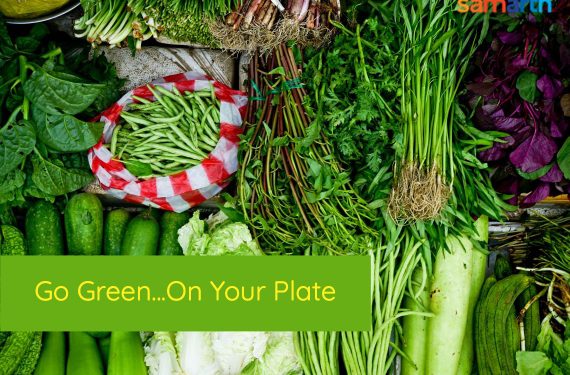It’s not good to go green with envy; that’s not healthy at all. However, you could choose to go green with your diet and gain lots from it. Seniors need to have a balanced diet to maintain their immunity and keep the doctor at bay. In India, we are lucky to have a steady supply of various greens throughout the year. Some are region specific, whereas some are available across the country.
Some greens like the Methi, Palak, Amaranth, etc., are common across India. At the same time, a Gongura is identified with Andhra Pradesh and Mustard greens (Sarson) and radish leaves with Punjab, drumstick leaves or Moringa in the South, Haak or Collard in Jammu and Kashmir, Kalmi in West Bengal and Karnataka.
Health benefits

Join Now >
Typically, most of these greens are powerhouses of nutrients; they contain a variety of Vitamins, Iron, folate, Potassium, Calcium, and antioxidants. Most of them also contain a good amount of fibre that is extremely good for gut health. Some of them also contain highly beneficial Omega 3 fatty acids. Most of these are essential for our body in many ways to keep it healthy, whereas a few others provide us with extra protection from infections, including cancer.
While they contain nutrients and fibre along with water, they are also low on calories. Folate present in these is also said to help improve moods by reducing stress. This aspect, along with fibre, also helps in blood sugar management. Thus, it becomes a wholesome food that should ideally be a regular part of a senior’s balanced diet.
Other benefits
One other benefit of including greens in the diet is that it is easily available in the market and are usually inexpensive. Also, many of these can be easily grown at home as well in pots. It can also be cooked in various ways easily; they cook fast and blend easily with a lot of other vegetables. Some of them can be mixed in idli/dosa batter or roti/poori atta as well. You could make gravies, soups, juices or use the choppings as salad toppings. They could also be used in chutneys, kebabs or raithas. Some of them are pickled or made into chutney powders for longer shelf life. Thus, the greens are versatile veggies that can be used in multiple ways and cooked easily to dish out a healthy delicacy in a jiffy. Some even use it in savouries and pakodas, which may be slightly unhealthy, though not if eaten occasionally. Here is a list of some of the regional, seasonal and uncommon greens from across India.
Drumstick Leaves (Moringa Leaves, Sajjan Saag)
This one is common in most South Indian states, even though not in urban areas. However, the leaves of drumstick are highly medicinal and are recommended for consumption even during chemotherapy. They are an excellent source of Vitamin C and K, and Iron, besides Calcium, Magnesium, Vitamin B2 and beta-carotene. Traditionally, it has been considered a remedy for malnutrition, and it can even keep diabetes and cancer at bay.
Haldi Leaves (Turmeric Leaves)
Haldi and its medicinal values are well known to Indians, and it is a regular in Indian cuisine. However, few people are aware that the leaves are also used in cooking. In the coastal areas where the monsoon causes seasonal issues like cold, cough and allergies, these leaves are used to keep infections at bay or cure. They are rich in fibre and curcumin and have high anti-inflammatory and antiseptic (antibacterial and antifungal) properties.
They are used as herbal concoctions or in regular cooking to ensure the flavour and the essence of the leaves get into the food. For example, the leaves are used while cooking rice, kheer or some delicacies are steamed in them. Examples are patholi, a sweet dish or spicy fish baked or steamed in them.
Arbi/Taro/Colocasia Leaves
Many states of India have their own indigenous way of cooking Taro leaves. These leaves are rich in Vitamin A and C, as well as Iron and fibre. They can help boost your immunity, regulate cholesterol and blood pressure, and improve your eyesight. The multiple dishes made out of this are Patro, Alu vadi, Patrado, Alvati, Patal Bhaji, Usli, Pakoda, etc. There are many similarities in the rolls made out of it in various parts but differ in a few ingredients.
Pui Saag/Malabar Spinach
These heart-shaped greens grow as climbers and are also known as basale soppu and vaali in the South. Highly nutritious, these are known to help heal mouth ulcers, improve immunity and digestion. In addition, the fibre in them helps keep the digestive system healthy. These come with the stem, and both the leaves and stems are full of fibre and water that can be cooked and eaten easily.
Kalmi Saag/Anne Soppu
This water spinach grows wild around the paddy fields and is mostly eaten in Karnataka and West Bengal. Like other spinach varieties, this one too is a powerhouse of nutrients containing Calcium, Iron, Vitamin A and C, fibre, and protein. This helped people sustain lives during the great Bengal famine and is hugely popular in the state. It can be made into chutney or made into a quick stir-fry. It is good for anaemia, indigestion, diabetes and even heart diseases.







